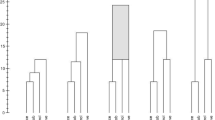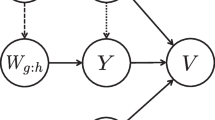Abstract
This paper aims to present a modified version of Bayesian Rose Trees (BRT). The classical BRT approach performs data clustering without restricting the resulting hierarchy to the binary tree. The proposed method allows for constraining the resulting hierarchies on the basis of additional knowledge. Thanks to this modification, it is possible to analyse not only the raw structure of the data but also the nature of a cluster. This allows an automatic interpretation of the resulting hierarchies while differentiating between clusters of different magnitudes, or those that extend significantly through one pair of dimensions while being coherent in a different one. On the basis of the resulting modifications, it is possible to analyse the depth level as a function of likelihood. The developed method allows maximising customisation possibilities and comparative analysis between the nature of clusters. It can be applied to the clustering of different types of content, e.g. visual, textual, or in a modern approach to the construction of container databases.
Supported by organization Infotower sp. z o.o., Wincentego Pola 16, 44-100 Gliwice, Poland.
Access this chapter
Tax calculation will be finalised at checkout
Purchases are for personal use only
Similar content being viewed by others
References
Huk, M.: Measuring the effectiveness of hidden context usage by machine learning methods under conditions of increased entropy of noise. In: 2017 3rd IEEE International Conference on Cybernetics (CYBCONF), Exeter, pp. 1–6 (2017)
Kwiatkowski J., Huk, M., et al.: Context-sensitive text mining with fitness leveling genetic algorithm. In: 2015 IEEE 2nd International Conference on Cybernetics (CYBCONF), Gdynia, Poland, 2015, pp. 1–6 (2015). ISBN: 978-1-4799-8321-6
Mizera-Pietraszko J., Huk M.: Context-related data processing in artificial neural networks for higher reliability of telerehabilitation systems. In: 17th International Conference on E-health Networking, Application & Services (HealthCom 2015). IEEE Computer Society (2015)
Huk, M., Szczepanik M.: Multiple classifier error probability for multi-class problems. Eksploatacja i Niezawodnosc-Maint. Reliabil. 51(3), 12–16 (2011)
Privitera, C.M., Azzariti, M., Stark, L.W.: Locating regions-of-interest for the Mars Rover expedition. Int. J. Remote Sens. 21, 3327–3347 (2000)
Huk, M.: Training contextual neural networks with rectifier activation functions: role and adoption of sorting methods. J. Intell. Fuzzy Syst. 37(6), 7493–7502 (2019)
Szczepanik, M., Jóźwiak, I.: Fingerprint recognition based on minutes groups using directing attention algorithms. In: Rutkowski, L., Korytkowski, M., Scherer, R., Tadeusiewicz, R., Zadeh, L.A., Zurada, J.M. (eds.) ICAISC 2012. LNCS (LNAI), vol. 7268, pp. 347–354. Springer, Heidelberg (2012). https://doi.org/10.1007/978-3-642-29350-4_42
Miller, G.A.: The magical number seven, plus or minus two: some limits on our capacity for processing information. Psychol. Rev. 63(2), 81–97 (1996)
Huk, M.: Weights ordering during training of contextual neural networks with generalized error backpropagation: importance and selection of sorting algorithms. In: Nguyen, N.T., Hoang, D.H., Hong, T.-P., Pham, H., Trawiński, B. (eds.) ACIIDS 2018. LNCS (LNAI), vol. 10752, pp. 200–211. Springer, Cham (2018). https://doi.org/10.1007/978-3-319-75420-8_19
Blundell, C., Teh, Y.W., Heller, K.A.: Bayesian rose trees. In: Proceedings of the 26th Conference on Uncertainty in Artificial Intelligence (UAI 2010), Catalina Island, California, USA, pp. 65–72 (2010)
Liu, S., Wang, X., Song, Y., Guo, B.: Evolutionary bayesian rose trees. IEEE Trans. Knowl. Data Eng. 27(6), 1533–1546 (2014)
Song, Y., Liu, S., Liu, X., Wang, H.: Automatic taxonomy construction from keywords via scalable bayesian rose trees. IEEE Trans. Knowl. Data Eng. 27(7), 1861–1874 (2015)
Ogawa, T., Saga, R.: Text-based causality modeling with a conceptual label in a hierarchical topic structure using bayesian rose trees. In: Proceedings of the 54th Hawaii International Conference on System Sciences, pp. 1101–1110. Hawaii International Conference on System Sciences (HICSS), Honolulu (2021)
Mehrotra, R., Yilmaz, E.: Extracting hierarchies of search tasks & subtasks via a bayesian nonparametric approach. In: Proceedings of the 40th International ACM SIGIR Conference on Research and Development in Information Retrieval, pp. 285–294. Association for Computing Machinery, New York (2017)
Jiang, H., Xiao, Y., Wang, W.: Explaining a bag of words with hierarchical conceptual labels. In: World Wide Web, pp. 1–21 (2020)
Heller, K. A., Ghahramani, Z.: Bayesian Hierarchical Clustering. In: Proceedings of the 22nd International Conference on Machine Learning (ICML 2005), pp. 297–304. Association for Computing Machinery, Bonn (2005)
Blundell, C., Teh, Y.W., Heller, K.A.: Discovering non-binary hierarchical structures with bayesian rose trees. In: Mixture Estimation and Applications. John Wiley and Sons, Hoboken (2011)
Meertens, L.: First steps towards the theory of rose trees. Working paper 592 ROM-25, IFIP Working Group 2.1 (1988)
Yamada, K.: Hypermatrix and its application. Hitotsubashi J. Arts Sci. 6, 34–44 (1965)
Gelman, A., Carlin, J.B., Stern, H.S., Dunson, D.B., Vehtari, A., Rubin, D.B.: Bayesian Data Analysis, 3rd edn. Chapman & Hall/CRC, Boca Raton (1999)
Pęszor, D., Wojciechowska, M., Wojciechowski, K., Szender, M.: Fast moving UAV collision avoidance using optical flow and stereovision. In: Nguyen, N.T., Tojo, S., Nguyen, L.M., Trawiński, B. (eds.) ACIIDS 2017. LNCS (LNAI), vol. 10192, pp. 572–581. Springer, Cham (2017). https://doi.org/10.1007/978-3-319-54430-4_55
Pęszor, D., Wojciechowski, K., Szender, M., Wojciechowska, M., Paszkuta, M., Nowacki, J.P.: Ground plane estimation for obstacle avoidance during fixed-wing UAV landing. In: Nguyen, N.T., Chittayasothorn, S., Niyato, D., Trawiński, B. (eds.) ACIIDS 2021. LNCS (LNAI), vol. 12672, pp. 454–466. Springer, Cham (2021). https://doi.org/10.1007/978-3-030-73280-6_36
Pęszor, D., Wojciechowski, K., Wojciechowska, M.: Automatic markers’ influence calculation for facial animation based on performance capture. In: Nguyen, N.T., Trawiński, B., Kosala, R. (eds.) ACIIDS 2015. LNCS (LNAI), vol. 9012, pp. 287–296. Springer, Cham (2015). https://doi.org/10.1007/978-3-319-15705-4_28
Acknowledgements
The research presented in this paper is co-financed by the EU Smart Growth Operational Programme 2014-2020 under the project POIR.01.01.01-00-1111/19 “Development of the advanced algorithms for multimedia data selection and the innovative method of those data visualization for the platform supporting customer service in the tourism industry”.
The work of Eryka Probierz was supported in part by the European Union through the European Social Fund as a scholarship Grant POWR.03.02.00-00-I029, and in part by the Silesian University of Technology through a grant: the subsidy for maintaining and developing the research potential in 2022 for young researchers in data collection and analysis.
The work of Damian Pęszor was supported in part by Silesian University of Technology through a grant number BKM-647/RAU6/2021 “Detection of a plane in stereovision images without explicit estimation of disparity with the use of correlation space”.
Author information
Authors and Affiliations
Corresponding author
Editor information
Editors and Affiliations
Rights and permissions
Copyright information
© 2022 The Author(s), under exclusive license to Springer Nature Switzerland AG
About this paper
Cite this paper
Pęszor, D., Probierz, E. (2022). Covariance Controlled Bayesian Rose Trees. In: Nguyen, N.T., Tran, T.K., Tukayev, U., Hong, TP., Trawiński, B., Szczerbicki, E. (eds) Intelligent Information and Database Systems. ACIIDS 2022. Lecture Notes in Computer Science(), vol 13758. Springer, Cham. https://doi.org/10.1007/978-3-031-21967-2_5
Download citation
DOI: https://doi.org/10.1007/978-3-031-21967-2_5
Published:
Publisher Name: Springer, Cham
Print ISBN: 978-3-031-21966-5
Online ISBN: 978-3-031-21967-2
eBook Packages: Computer ScienceComputer Science (R0)




